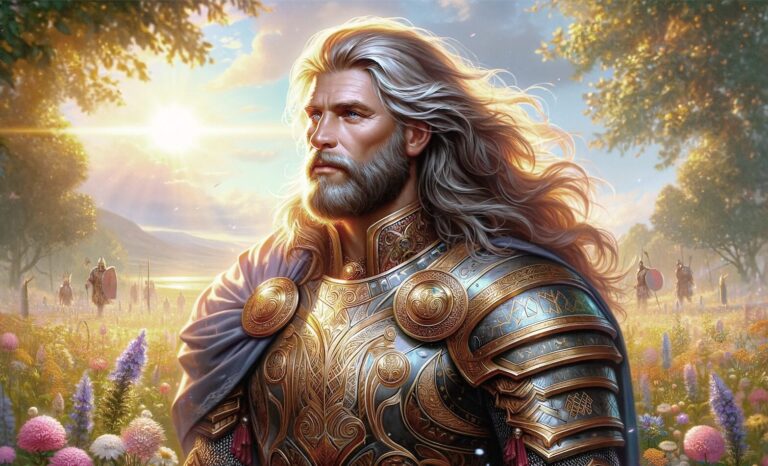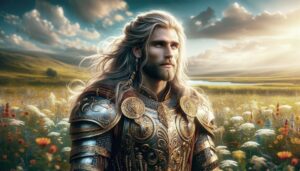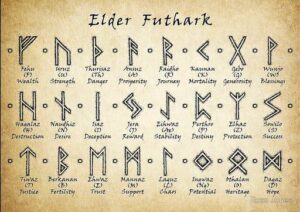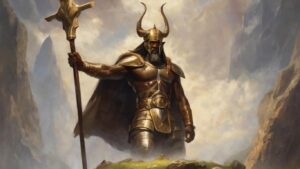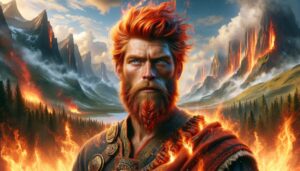Table of Contents
Who is Balder?
In Norse mythology, Balder, also spelled Baldur or Baldr, is a god associated with beauty, love, happiness, and light. He is the son of Odin, the chief god, and Frigg, the queen of the Aesir. Balder is often described as the most beloved of the gods, and his death is a significant event in Norse mythology.
According to the myth, Frigg, Balder’s mother, made all things promise not to harm her son, but she overlooked mistletoe. Taking advantage of this oversight, the mischievous god Loki tricked Balder’s blind brother Hodr into throwing a mistletoe dart at Balder, which resulted in his death.
Balder’s death is a pivotal event that leads to a series of events, including the onset of Ragnarok, the end of the world in Norse mythology. Balder’s association with light and purity, as well as his tragic demise, makes him a central figure in Norse mythology, and his story is often interpreted in various ways.
Descriptions of Balder’s physical appearance in Norse mythology are not as detailed as those of some other gods. However, he is generally depicted as a handsome and fair god, radiating beauty and light. His name, “Balder,” is etymologically related to words meaning “bright” or “shining,” emphasizing his association with light and purity.
While the sources do not provide specific details about his attire or physical features, the overall impression is that of a noble and radiant deity. In artistic representations, Balder is sometimes portrayed with golden hair and a serene countenance, symbolizing his divine attributes. As with many mythological figures, the specific details of Balder’s appearance may vary across different interpretations and artistic representations.
Family
Balder is a member of the Aesir, one of the two main groups of deities in Norse mythology. His immediate family includes:
Father: Odin – Balder’s father is Odin, the chief god of the Aesir. Odin is associated with wisdom, war, and magic.
Mother: Frigg – Frigg is Balder’s mother and Odin’s wife. She is a goddess associated with love, marriage, and motherhood. Frigg is often considered the queen of the Aesir.
Brother: Hodr (or Hod) – Balder’s blind twin brother. In the tragic myth of Balder’s death, Hodr is manipulated by Loki into unintentionally causing the death of his brother.
Balder’s familial connections tie him closely to the major deities in Norse mythology. His death and the events surrounding it play a crucial role in the overarching narrative of the mythology, particularly in relation to the prophecy of Ragnarok, the end of the world.
Balder’s origin lies in Norse mythology, where he is established as one of the Aesir gods, born to Odin and Frigg. His name, which means “the shining one” or “the brave,” reflects his association with light and beauty. Balder is considered a god of joy, purity, and happiness.
The mythology surrounding Balder is primarily found in the Poetic Edda, a collection of Old Norse poems, and the Prose Edda, a 13th-century work by the Icelandic scholar Snorri Sturluson. These sources provide insights into the Norse cosmogony, the genealogy of the gods, and the various myths that involve Balder.
A Dark Prophecy
One of the central elements of Balder’s mythology is a dark prophecy foretelling his death. According to the prophecy, Balder’s mother, Frigg, obtained oaths from all things in existence not to harm her son. However, she overlooked mistletoe, considering it harmless. Taking advantage of this oversight, the mischievous god Loki discovered the vulnerability and used it to orchestrate Balder’s demise.
The Death of Balder
The story of Balder’s death is a tragic and pivotal event in Norse mythology. In one version of the myth, Loki tricks Balder’s blind brother, Hodr, into shooting a mistletoe dart at Balder. As mistletoe was the only substance not sworn to protect Balder, it becomes the instrument of his death. Balder is fatally struck, and his death sends shockwaves through the divine realms.
The grief over Balder’s death contributes to the chain of events leading to Ragnarok, the apocalyptic battle that results in the destruction of the cosmos. The death of Balder is a symbol of the fragility of the divine order and foreshadows the ultimate upheaval that Ragnarok brings.
Balder’s story is not just a tale of tragedy but also serves as a narrative device in Norse mythology, emphasizing themes of fate, betrayal, and the inevitable cycle of destruction and renewal.
Symbols
In Norse mythology, symbols associated with Balder are not as explicitly defined as those of some other gods. However, certain symbols and themes are often linked to him based on his attributes and the events surrounding his mythology. Here are some potential symbols associated with Balder:
Light and Radiance: Balder is often associated with light, radiance, and beauty. As such, symbols of light, such as the sun or shining objects, can be linked to Balder.
Mistletoe: While mistletoe itself is not a positive symbol for Balder, its association with his death makes it a relevant symbol in the context of his mythology. Mistletoe serves as a reminder of the tragic event that led to Balder’s demise.
Joy and Happiness: Balder is considered a god of joy and happiness, so symbols representing these qualities might be associated with him. These could include symbols of celebration, laughter, and positive emotions.
Golden Hair: While not explicitly mentioned in the mythological sources, artistic representations sometimes depict Balder with golden hair, emphasizing his radiant and divine nature.
White or Pure Colors: Balder’s association with purity and beauty might be reflected in symbols of white or other pure colors, representing his divine essence.
Norse mythology doesn’t have a standardized set of symbols in the same way some other mythologies do, and interpretations can vary across different sources and artistic representations. The symbols associated with Balder are often inferred from his characteristics and the events of his mythology.
Modern Influence
Balder from Norse mythology has left a lasting impact on various aspects of modern culture, ranging from literature and art to popular media. Here are a few ways in which Balder continues to influence the contemporary world:
Literature and Art:
Writers and artists often draw inspiration from Norse mythology, including the character of Balder, to create modern works of literature and art. Balder’s story of tragedy and sacrifice provides rich material for creative endeavors.
Popular Culture: Norse mythology, including the tales of gods like Balder, has experienced a resurgence in popular culture. This is evident in movies, TV shows, and video games that incorporate Norse themes. For example, Balder is a character in Neil Gaiman’s novel “American Gods,” which has been adapted into a television series.
Video Games: Norse mythology, including the story of Balder, is often featured in video games. Games like the “God of War” series and “Assassin’s Creed: Valhalla” incorporate elements of Norse mythology, bringing characters like Balder to a wider audience.
Literary Adaptations: Authors often reimagine and adapt myths and legends in their works. Balder’s story, with its themes of fate, betrayal, and tragedy, serves as a compelling narrative that writers may reinterpret in different contexts.
Artistic Representations: Artists continue to create visual interpretations of Balder and other Norse deities. These representations can be found in various forms, from illustrations and paintings to sculptures and digital art.
Symbolism in Pop Culture: Symbols associated with Balder, such as light and mistletoe, may be subtly referenced in popular culture. Whether in logos, merchandise, or other forms of media, these symbols can carry deeper mythological meanings.
While Balder may not be as widely recognized as some mythological figures from other traditions, his influence persists in both traditional and modern forms of storytelling, contributing to the ongoing fascination with Norse mythology in the contemporary world.
Balder FAQ
Who is Balder in Norse Mythology?
Balder is a god in Norse mythology, part of the Aesir, one of the two main groups of deities. He is the son of Odin, the chief god, and Frigg, the queen of the Aesir. Balder is associated with beauty, love, happiness, and light. His story is marked by a tragic death that plays a significant role in Norse mythology.
What is Balder the God of?
Balder is often considered the god of beauty, love, joy, happiness, and light. He is described as the most beloved of the gods in Norse mythology, representing positive and radiant qualities.
Why Did Loki Kill Balder?
In Norse mythology, Loki orchestrated the death of Balder due to a combination of mischief, jealousy, and a dark prophecy. Balder's mother, Frigg, had secured oaths from all things not to harm her son, except for mistletoe, which she considered harmless. Loki, aware of this vulnerability, tricked Balder's blind brother, Hodr, into using mistletoe to unwittingly cause Balder's death.
How Did Loki Kill Balder?
Loki tricked Hodr, Balder's blind brother, into shooting a mistletoe dart at Balder during a game in which the gods were testing Balder's invincibility. Since mistletoe was the only substance not bound by Frigg's protective oaths, it became the instrument of Balder's death.
How Did Balder Die?
Balder died as a result of being struck by a mistletoe dart thrown by Hodr, manipulated by Loki. The mistletoe, overlooked by Frigg in her efforts to protect her son, became the one element capable of causing harm to Balder. This event marked a tragic turning point in Norse mythology, leading to a series of events that ultimately contribute to Ragnarok, the end of the world in Norse cosmology.
